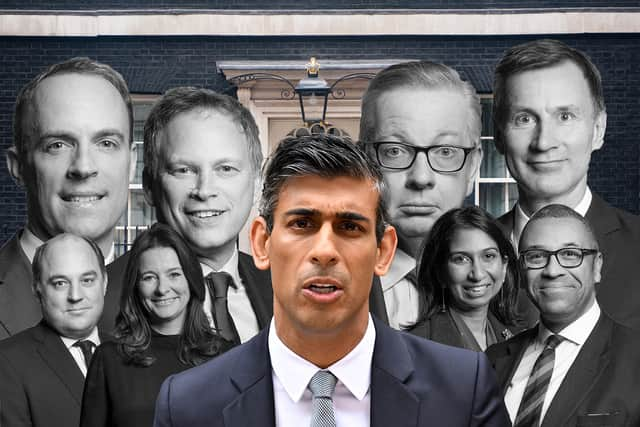Rishi Sunak new Cabinet: number of women appointed - gender split explained and why new PM has been criticised
and live on Freeview channel 276
Rishi Sunak‘s Cabinet has the fewest women since the Cameron-Clegg coalition from over a decade ago.
The new Prime Minister yesterday (25 October) announced his Cabinet, bringing back a fair few familiar faces, such as Jeremy Hunt and Ben Wallace, and controversially opting to reappoint Suella Braverman just days after she resigned for breaking the Ministerial Code.
Advertisement
Hide AdAdvertisement
Hide AdBut another point of controversy surrounding Sunak’s Cabinet is the gender split. Of all the ministers who will attend Cabinet, less than a quarter are women. This is fewer than the number during Liz Truss and Boris Johnson’s premierships, and fewer than those included in David Cameron’s second Cabinet in 2015.
Labour has already slammed the lack of representation, with shadow women and equalities secretary Annelise Dodds writing on Twitter: “I know the Conservatives struggle to add up, but women make up half the population. This isn’t a fresh start, it’s just jobs for the boys.” A Tory Party source also seemed to agree, remarking: “It’s all very at odds with his speech - all the blokes in the top jobs.”
So exactly how many women has the new Prime Minister appointed to his government? Here’s how his Cabinet compares to previous ones in terms of gender - and why it matters.


How does Rishi Sunak’s Cabinet compare to previous governments?
Just seven out of the 31 government ministers who attend Cabinet are women. This equates to just under a quarter, or 23%.
Advertisement
Hide AdAdvertisement
Hide AdThis is down from nearly a third at the start of Liz Truss’ premiership, where 10 of the 31 Cabinet attendees were women (32%). This was the highest proportion ever for a prime minister’s first Cabinet, and also represented the first time a white man did not hold one of the country’s four most important ministerial positions.
The number of women in Sunak’s Cabinet is also lower than the equivalent figure for Boris Johnson (24%), Theresa May (30%), and David Cameron’s 2015 Cabinet (31%). The last time there were fewer women was in the first Cabinet of the Cameron-Clegg coalition over a decade ago, where the proportion was at just 17%.
Thérèse Coffey’s spell as the first woman to formally hold the role of Deputy PM lasted just 49 days.


Why does it matter?
If you take away the statistical comparisons, what this means in practice is that less women will be attending Cabinet meetings and taking part in government discussions. The majority of these discussions of course will impact the whole population, half of whom are women, meaning those in charge are not representative of those they are serving.
Advertisement
Hide AdAdvertisement
Hide AdSo, if less women are attending Cabinet - less women have a say on the key decisions made by the government. There’s the danger then that a male-dominated Cabinet will result in women’s issues and needs going by the wayside.
Mandu Reid, leader of the Women’s Equality Party, told NationalWorld she was concerned that the new administration was “utterly failing women.” She said she is worried by the “the lack of urgency this new government has when it comes to addressing the gendered impacts of the pandemic and subsequent cost of living crisis”, both of which she said “have led to a spike in violence against women, soaring domestic abuse rates and a childcare crisis which is pushing women out of the workplace and setting equality back by decades.”
Reid concluded: “We have a government utterly failing women here, both in representation and in policy.”
What has the public reaction been?
Many have taken to social media to share their views on the appointments.
Advertisement
Hide AdAdvertisement
Hide AdResearch Director at the Resolution Foundation James Smith wrote on Twitter: “Whatever your views on the political makeup of the new cabinet, 1-in-4 women simply isn’t good enough.” He went on to point out: “Evidence suggests this raises the risk of poor decision making.”
Another user, @ktmaxi, commented: “Women do happen to live in this country too, Rishi, and we do need to be represented at the highest level. What’s going on?”
Others opted to defend the appointments by pointing out that the Tories are the only party to have had a female prime minister. Replying to the Shadow Women and Equalities Secretary’s tweet on the topic, user Richard Brook wrote: “If you’re going to make such a fuss remember they’ve had 3 female PMs, you’ve had none.”
Other users meanwhile did not care about the gender split, writing that they were more concerned about the government ministers’ capabilities - or lack thereof. @dearaunty wrote: “I don’t need to feel ‘represented’ because of my sex. I just want the government to run the country properly.”
Comment Guidelines
National World encourages reader discussion on our stories. User feedback, insights and back-and-forth exchanges add a rich layer of context to reporting. Please review our Community Guidelines before commenting.
